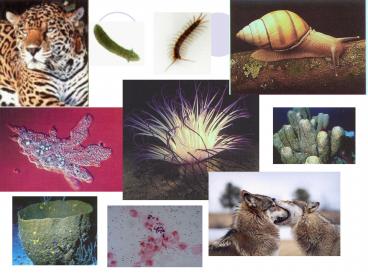Diversity Lecture - PowerPoint PPT Presentation
1 / 21
Title:
Diversity Lecture
Description:
Title: Diversity Lecture Author: Ponderosa High School Last modified by: dcsdk12 Created Date: 2/23/2006 7:22:18 PM Document presentation format: On-screen Show – PowerPoint PPT presentation
Number of Views:70
Avg rating:3.0/5.0
Title: Diversity Lecture
1
(No Transcript)
2
Naming organisms
- Aristotle was the first to classify
- Plants and animals
- Animals were blood and bloodless
- How they moved
- Very primitive
3
Naming Organisms
- Carolus Linnaeus
- Swedish
- Divided into Animal and Plant Kingdom
- Divided into even small groups
- Came up with naming system
- Binomial nomenclature
- 2 names Genus and species
- Genus always CAPITALIZED, species lowercase
- If written, underlined or typed italics
- All organisms have a common name (like humans
and a scientific name Homo sapiens
4
Naming Organisms
- Today we have 6 major kingdoms
- This is recent
- Animals are divided now not only based on looks,
but on genetics. - Video on Linnaeus
5
Hierarchy
- Domain
- Kingdom
- Phylum
- Class
- Order
- Family
- Genus
- Species
6
(No Transcript)
7
6 Kingdoms
- Archaebacteria
- Eubacteria(bacteria)
- Protista
- Fungi
- Plantae
- Animalia
Monera
8
Kingdom Animalia
- All members are eukaryotic
- All members are heterotrophic
- All members are multicellular
- All members can move at some point in their lives
- MOST have specialized tissue
9
Animal Cell Structure
10
Asexual Reproduction
- Only 1 parent
- No special reproductive organs
- Genetically identical offspring (unless a
mutation occurs) - Called clones
- Typically very rapid
- No gametes (egg or sperm)
- Some invertebrates do this such a hydra
11
Types of Asexual Reproduction
- Binary Fission- Only bacteria and protozoa does
this (no animals) - Split by mitosis
12
(No Transcript)
13
Types of asexual reproduction
- Multiple fission nucleus divides repeatedly
before division making many young. - Does not occur in animal kingdom
14
Types of Asexual Reproduction
- Budding
- Unequal division
- Parent develops outgrowth or bud
- Bud grows organs and detaches
- Cnidarians like hydra
15
Types of Asexual Reproduction
- Gemmulation
- Make a gemmule
- Cells surrounded by a resistant capsule form
- Fresh water sponges do this
16
Types of Asexual reproduction
- Fragmentation
- Multicellular animal breaks into 2 or more parts
- Each fragment becomes an individual
- Planarians and other worms
17
Sexual Reproduction
- Production of offspring from 2 parents
- Form gametes (egg and sperm) through meiosis
- Takes more energy, but better way to reproduce
- Creates genetic variation
18
Sexual Reproduction Types
- Production of offspring from the union of 2
gametes from 2 genetically different parents - Meiosis
- Makes sex cells
- Egg and sperm
- Male and female
19
Sexes (male and female)
- When an organism displays 2 different sexes (male
and female) it is called dioecious - When an organism has both sex parts we call it
monecious or hermaphroditic. - Flatworms, annelids, barnacles and some fishes
are common for this. - Some fertilize themselves many dont
- Some can change sexes- sequential hermaphrodites
(genetically programmed)
20
Sexual Reproduction
- Parthenogenesis
- Embryo from unfertilized eggs form
- Not as common
- Some sharks and fish
- Some worms
- Some insects
- Some crustaceans
21
Sexual Reproduction
- 3 types of offspring formation
- Oviparous-egg birth
- Fertilization may be internal or external
- Ovoviviparous- egg birth but the egg is retained
in the body while development occurs - Certain fishes and reptiles
- Viviparous-egg develops in oviduct or uterus































